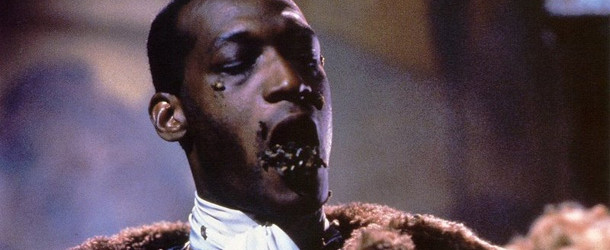The mid ‘80s to the mid ‘90s was a rough time for the horror genre. Most movies that attempted to scare usually scared up only laughs. Fright films went from gritty and haunting to campy and amusing. Critters, Troll, and all those relentless Return of the Living Dead movies… nothing was scary. Even franchises like Poltergiest, Nightmare on Elm Street, and Friday the 13th lost their footing after a solid first entry.
Luckily, Candyman stands out among those stinkers. And not only because its standing against a backdrop amongst a bunch of ugly cousins, but because it tells a smart and ironic story masterfully directed by British horror novelist Clive Barker. Coming off of the first three Hellraiser movies, one might expect a film like this to feature large moments of obscurity that tend to be more ridiculous than frightening, but Candyman keeps the tone consistent in mystery and suspense.
The film first sets up the local urban legend of the same name. A girl and her boyfriend, while babysitting, decide to look into the mirror and recite “Candyman” five times in order to summon a large man with a hook. It’s a hybrid between the popular “Bloody Mary” tale and “The Hook” urban legend. We soon see that this story is being recounted to Helen Lyle (Virginia Madsen), a graduate student at a Chicago-based university, researching urban legends. She’s fascinated by what she hears, and she wants to learn more. With her student sidekick Bernadette (Kassi Lemmons) at her side, she embarks on her journey to the Chicago projects, where the “Candyman” is rumored to haunt, to get to the bottom of things.
Not everything works in the movie, but when it succeeds, it does so because of Virginia Madsen’s triumphant performance. She plays the role on a tight rope, balancing her passion for her thesis against a caution of venturing where she shouldn’t. The Chicago projects aren’t exactly a safe place for middle-class women to snap some photos for their passion project. From what could easily be interpreted as the typical big-breasted blonde following strange noises, Madsen instead shows intelligence and determination. Helen isn’t oblivious, naïve, or trying to prove she’s tougher than she looks. In her own way, she’s trying to help rid this culture of this phantom by exposing the truth behind it. It’s no wonder she won the Saturn Award from the Academy of Science Fiction, Fantasy & Horror Films for this performance. She’s almost too good for the material she’s given.
The movie also deals with a lot of dramatic irony. The symbol of the hook has been known to suggest a forager. While the titular character dons a hook for a hand, Madsen’s Helen sports an invisible one. While Helen isn’t literally on the hunt for food, her appetite can only be whet with the sustenance of knowledge. Funny enough, a little food for thought about knowing her limitations would have served her well. Without sounding too campy, her quest is essentially to supply the projects with the proper knowledge, i.e. nutritional guidance. It’s in this pursuit for enlightenment that leads to her downfall. Curiosity kills that cat.
There are largely two elements that don’t work. One, the Candyman’s pursuit of Helen, after she steps into his territory, isn’t explained very well. What does he mean when he says he wants them to be one together, forever? Is he in love with her all of the sudden? I don’t want to give too much away—some of what he says makes sense, but not any of this nonsense. And second, a lot of the backstory regarding Candyman and the urban legend is told via expository dialogue. It’s believable, but a bit sloppy. She learns a great deal about the legend while sitting at dinner with another professor. It would have been more appropriate to have her discover the information for herself while being active in her search for it, rather than having it just fall into her lap. I also didn’t love the synthetic score at first, but as the movie goes on, the score becomes more and more haunting and powerful—mirroring Helen’s descent into supposed madness.
Watching the movie also somewhat represents a culture that doesn’t exist today. Most graduate research is done with the assistance of the Internet, and the use of photographic slides, which Helen plans to use to support her thesis, is obsolete. Also gone are when chain-smokers like Helen could smoke freely in universities and restaurants. And even the project buildings where this movie took place (on location), I understand to be revamped and remodeled, and occupied by students.
It’s a great movie that represents the zeigeist of the early ’90s, and a strong contender for the best horror movie of that period.








